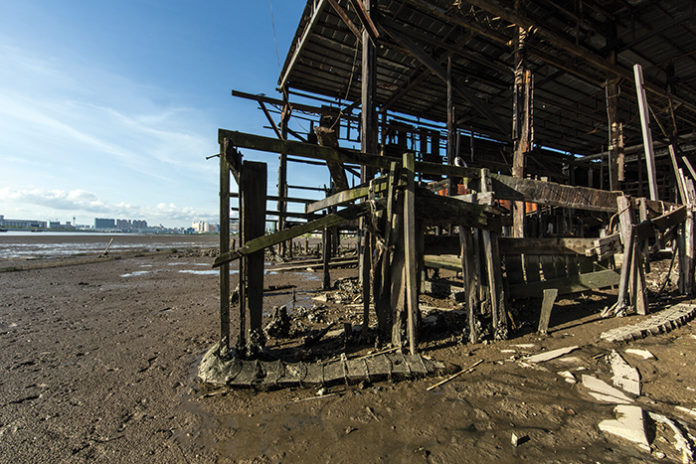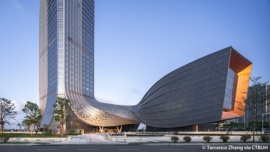In April 2017, the Macau SAR Government halted the destruction of the derelict shipyards sited in south-western Coloane. This was the same place it had ordered demolition just a month earlier, on the grounds of safety hazards to the population and visitors to the area.
“In March 2017, the government commenced the destruction of the two lots which were in the worst conditions due to the lack of long-term maintenance, and which had already caused the collapse of part of its structure, constituting a risk for public safety and the sanitation of the area,” a DSSOPT spokesperson explained to Macau Business.
But public sentiment would not let the government pursue its plans. Popular mobilisation and pressure from public opinion have forced the government to retrace its steps, reframing the fate of the shipyards.
Following the reversal, the Secretary for Social Affairs and Culture, Alexis Tam Chong Veng, made a pronouncement on the sidelines of the plenary meeting of the Cultural Heritage Committee on April 12, 2017, proposing two directions for the site. Not only the shipyards would now be targeted, once again, for renovation – with maintenance work to start in timely manner due to the approach of the typhoon season – but they would be listed and proposed to UNESCO as a heritage site.
How the government is to move from keeping the structures standing to turning it into a World Heritage site, however, is still too early to ponder.
António Conceição Júnior, a member of the Cultural Heritage Committee, told Macau Business that the first thing to be considered is producing a plan for the area, without which nothing worth doing could be achieved.
“I don’t think that a proposal to UNESCO makes much sense at this stage. It would be necessary to elaborate a report, but one that considers the shipyards as part of the surrounding area, including the temple and the village. The Secretary [Alexis Tam] said there is some urgency and hurry in this, but I think there should be a project, a programme for the area.”
Be kind, rewind
In 2012, the government stepped out to publicly pronounce its intention of renovating the shipyards. A proposal study was presented on that occasion to the population of the village.
“The government was presenting [the study] to people in a kind of public consultation. They were studying the whole area. They had all the documents and already showed what was broken, the shipyards that were messed up, and everything,” explains David Pinto Marques, who lives in the area and has been involved in activities to raise public awareness about the cultural and historical value of the site as President of the Lai Chi Wun Villagers Association.
The official release concerning the government’s initiative nearly five years ago is still available online on the website of the Government Information Bureau.
‘The shipyards for fishing boats located in the settlement of Lai Chi Vun in the village of Coloane are one of the rare places in which it is possible to witness the ancient art of large shipbuilding in the Pearl River Delta Region. In view of the conservation of this ancient art, the competent services have proceeded to the planning study of Coloane Village. Therefore, it is proposed that emphasis be placed upon the culture of shipbuilding, focused on the local population, preserving the cultural atmosphere and local customs of the village of Coloane,’ the release reads.
Although none of the bureaus consulted for this story – the Land, Public Works and Transport Bureau (DSSOPT), the Marine and Water Bureau (DSAMA), and the Cultural Affairs Bureau (CAB) – volunteered to provide a copy of the study in question, DSSOPT briefed us on what the study comprised.
‘With the participation of several departments, mainly the Land, Public Works, and Transport Bureau and the Maritime and Water Bureau, the Planning Study for the Lai Chi Wun settlement in Coloane Village was preliminarily concluded at the end of 2012, and was published in the first quarter of 2013, in order to collect public opinions, which in turn, would be considered together with the opinion of this department. Today, the study constitutes an internal reference for future work of the relevant departments.’
Macau Business managed to gain access to the proposal scheme dated January 2013, which served as the basis for the public consultation with Pinto Marques, who kept a copy of it, along with other documents collected since the government started preparing to intervene in the area.
“The government had a plan; now they say there is no real plan, that it was for internal stuff, but we have a copy of those. There was a plan – not really going [for] massive building construction, or the capitalist way, but toward a more humanitarian way, benefiting the villagers. Now, nobody knows what the status of it is. They say it is for ‘internal review.’ What do they mean by internal review – who is reading it? But, of course, we put our trust in the government.”
The project consisted of developing different cultural and artistic activities within the site, broken down into several smaller units or ‘plans’ (see box). These roughly included a shipyard building exhibition area, a plan for integrating or ‘harmonizing the shipyards site with the surrounding environment, namely, the village, and a multi-functional leisure and cultural tourism area. An outdoor space with food and beverage retail and a recreation area was also planned.
Pinto Marques believes that what is being planned for the shipyards now may result in being very similar to this proposal, if not exactly the same.
Shipyards gone with the wind
According to information provided by DSAMA, the 18 plots located in the Lai Chi Vun shipyards area constitute public domain.
As a matter of fact, there is no property description of the plot or the plots where the shipyards are located in the city’s Property Registry Office. This means that the land is owned by the government.
DSAMA’s spokesperson confirmed that information by phone on April 21, adding that the licences for usage of the area are issued annually, and that the licence fees are paid to the same bureau ‘pursuant to the general table of fees of the Marine and Water Bureau,’ with the amount disclosed in the Official Gazette. Licence holders are charged MOP12 per year per square metre occupied on the plot.
‘In order to support the ship construction industry, the use of those plots is allocated to the holders of the provisional occupation licence within jurisdictional waters, enabling the function of activities related to the construction and repairing of boats,’ DSAMA pointed out.
According to the bureau, the legal conditions underlying the provisional occupation licences stipulate that ‘it is the obligation of the licence holders to conduct repair and maintenance of the attendant facilities in order to guarantee safety.’
Clearly, there was not enough maintenance to avoid the conclusion reached in late 2016 that the shipyards should be torn down.
The mystery that remains to be answered is why the marine bureau continued to renew the licences yearly if the conditions for keeping rights of occupancy of the shipyards were not being fulfilled by the licence holders.
Speaking with us, DSSOPT clarified that ‘during the period from 2013 to 2015, the Maritime and Water Bureau has, at least five times, informed the occupants of the 11 sites by official letter requesting maintenance of the facilities as soon as possible. However, the occupants did not perform the maintenance and did not use the lot in accordance with the intended use.’
DSSOPT also said that negotiations involving the non-renewal of the licences started in May 2016, and that between October and mid-November of that year the occupants of the site removed their belongings from the lot.
Thus, a conclusion was finally reached and the mystery solved.
DSAMA did not reply to Macau Business’ enquiries about the availability of funds from the bureau or other government department for the licence holders who would be, if at all, willing to undertake renovation or maintenance work on the site, claiming that they did ‘not have further information at this stage’ to provide.
Apart from the lack of information on funds available, Pinto Marques raised the question of multiple or unknown ownership of the shipyards.
“In one of the shipyards which was destroyed [in April 2017], a villager was still living there, and said he was partly an owner. But we don’t know. We never know [for sure] because maybe [the licence holder] sold his share and he is not the owner anymore. So, he does not have an incentive to make it nice or anything,” he explained.
Pinto Marques added that there is the question of how well informed and capable to pursue what they are supposed to do these people actually are.
“[I discovered] the literacy rate there was so low. ‘Oh, right, they didn’t go to school.’ That’s why the information is always being repeated, redundant. Suddenly, you have a new fact coming up, a rumour fact. The rumour mill is so strong that it’s hard to extract information that is accurate.”
Sitting idly or the art of building ruins
Speaking to Macau Business, a CAB spokesperson explained that back in 2012 the cultural bureau had expressed its opinion about the value of ‘the art of naval construction in daily life and in the morphology of the [Lai Chi Vun] settlement, considering that those values should be maintained and maintained in a visible manner,’ following DSSOPT plans for renovating the shipyards.
But while the Bureau kept pushing for renovation, and the licence holders did not perform accordingly, the shipyards kept falling apart.
As a result, a joint assessment conducted by DSSOPT and DSAMA led the government to conclude that the shipyards should be sealed ‘in order to guarantee the safety of residents and [pedestrians]’ of the area, DSSOPT told us.
The conclusion to this proposition is well-known, with the government announcing that it was going to destroy the shipyards in early March 2017.
Not so fast, my friend
“The associations [in Lai Chi Vun] are very interesting. Civil society offered a big contribution to changing the mindset about the shipyards,” believes José de Sales Marques.
In addition to his previous functions on top administrative jobs in the city, often connected to urban planning and design, Sales Marques had also coordinated a study proposal for the shipyards area back in 2013 with local and international students from the Polytechnic of Milan.
In Conceição Júnior’s opinion, there is much more awareness now compared to the late 1970s, when there was only an incipient idea of heritage preservation in the city.
“When I came back in 1977, there was already an idea of heritage, with Francisco Figueira [an architect]. But, naturally, there were no laws, or people so sensitised to it as they are today. But there is a legacy, and, fortunately, awareness is much broader now, including on the part of the Chinese population, who have also manifested themselves in defence of the Guia Lighthouse,” Conceição Júnior claimed.
João Palla, a member of Architects Without Borders in Portugal, also got involved with the activities. Speaking to Macau Business, he explained that he launched a petition online when it came to his knowledge that the shipyards were being destroyed.
“The only thing I asked was to stop the demolition because there was already another petition which asked the CAB to assess the heritage value of the site. Later on, another petition emerged,” the architect revealed.
As for Pinto Marques, who believes the local level of literacy is “a key factor” in the idea of bringing up change to the site, he is doing his bit by making another type of contribution.
“For what I’m doing there, I am trying to make the community [evolve] in a better way, more positively. So, I am trying to help with that bit first, by having a little library, still working on that one, but almost finished. They read newspapers and everything, but if you visit their houses you don’t see books. You see a lot of cooking, always good. But you don’t see any books.”
With a plan and a library, what is lacking?
Co-ordination.
“The government should seek to co-ordinate all these actions in a way that is efficient because this kind of contribution demands co-ordination on the part of the government. The government should work as a whole, with multi-disciplinary and multi-services teams,” proposes Sales Marques.
The historical and cultural value of the shipyards no longer seems to be questioned. Since the government has oscillated in its decision and reversed it, it has embraced the same conclusion it reached nearly five years ago; that is, that the site should be preserved. Meanwhile, CAB is sticking to its original opinion.
“The area of the shipyards in Lai Chi Vun gradually took shape in the 1950s and 1960s, witnessing the old industry of naval construction in Macau. CAB understands that the value of Lai Chi Vun is also rooted in the global landscape of the area, respecting the harmonious relationship between the targeted site [the shipyards], the mountains, and the maritime coast,” the cultural bureau claimed.
The shipyards are not old when compared to some of the ancient buildings listed in the city, particularly temples and churches, with some of them standing since the fifteenth and sixteenth century. Conventional UNESCO criteria value history, or the age of buildings, in addition to architectural originality and craftsmanship.
But reading from CAB’s statement, there is more to it: the history of Coloane itself, which Sales Marques also highlights.
“We need to look further, so that we consider not only the maritime history but also the history of Coloane, its roots, its development, the stories there that are to be told. The fact that Coloane was a basis of piracy activity is very interesting. There are several romantic things about this place. Isn’t it funny that the Lord Stow egg tarts were born in a nest of pirates? The police school is there, a work by Carlos Marreiros. There is an important temple, the bamboo opera theatre, the tradition of oyster fishing, of salted fish. There are so many things and it is so rich – and all this is part of that site,” he noted.
Currently, CAB is taking steps to list the site. ‘CAB will open the procedure to classify the Lai Chi Vun shipyards area and is actively working on the matter.’
Here it is, written again, so there is no doubt this time.
***
Highlights from the previous proposal for the preservation of the shipyards’ site (2012/2013)
Plan 1
Value and promote the shipyards industry and living history
Preserve the whole area, including the waterscape
Create a workshop and exhibition space for ship construction
Plan 2
Respect indigenous life and revive the site by making use of the existing structures
Develop a cycling lane and pedestrian areas
Create space for the selling of locally designed products and craft
Plan 3
Preserve the shipyards’ feature as a historical site
Use the area as a space for leisure and entertainment activity
Develop a multi-function tourism area, connected to the development of accommodation nearby
Lychee Bay
The Chinese name that designates the shipyards site, ‘Lai Chi Vun” (or Wun), is said to be associated with the abundance of lychee (lai chi) trees that could be found there in the past, as well as its bowl-shaped (wun) bay.
Source: Macao Streets, IACM
























